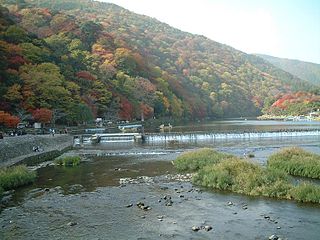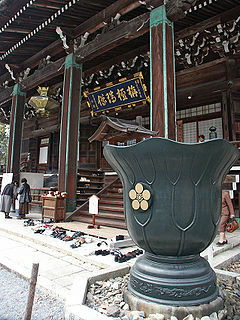
Kinkaku-ji, officially named Rokuon-ji, is a Zen Buddhist temple in Kyoto, Japan. It is one of the most popular buildings in Japan, attracting a large number of visitors annually. It is designated as a National Special Historic Site, a National Special Landscape and is one of 17 locations making up the Historic Monuments of Ancient Kyoto which are World Heritage Sites.

Enryaku-ji is a Tendai monastery located on Mount Hiei in Ōtsu, overlooking Kyoto. It was founded in 788 during the early Heian period (794-1185). The temple complex was established by Saichō (767–822), also known as Dengyō Daishi, who introduced the Tendai sect of Mahayana Buddhism to Japan from China. Enryaku-ji is the headquarters of the Tendai sect and one of the most significant monasteries in Japanese history. As such, it is part of the UNESCO World Heritage Site "Historic Monuments of Ancient Kyoto ". The founders of Jōdo-shū, Sōtō Zen, and Nichiren Buddhism all spent time at the monastery. Enryaku-ji is also the center for the practice of kaihōgyō.

Arashiyama is a district on the western outskirts of Kyoto, Japan. It also refers to the mountain across the Ōi River, which forms a backdrop to the district. Arashiyama is a nationally designated Historic Site and Place of Scenic Beauty.

The Philosopher's Walk is a pedestrian path that follows a cherry-tree-lined canal in Kyoto, between Ginkaku-ji and Nanzen-ji. The route is so-named because the influential 20th-century Japanese philosopher and Kyoto University professor Nishida Kitaro is thought to have used it for daily meditation. It passes a number of temples and shrines such as Hōnen-in, Ōtoyo Shrine, and Eikan-dō Zenrin-ji. It takes about 30 minutes to complete the walk, although many people spend more time visiting the sights along the way. On the northern part of the walk, there are good views of the nearby Daimonji. The walk is a popular destination for tourists and locals, especially during hanami.

Ginkaku-ji, officially named Jishō-ji, is a Zen temple in the Sakyo ward of Kyoto, Japan. It is one of the constructions that represents the Higashiyama Culture of the Muromachi period.

Nanzen-ji, or Zuiryusan Nanzen-ji, formerly Zenrin-ji, is a Zen Buddhist temple in Kyoto, Japan. Emperor Kameyama established it in 1291 on the site of his previous detached palace. It is also the headquarters of the Nanzen-ji branch of Rinzai Zen. The precincts of Nanzen-ji are a nationally designated Historic Site and the Hōjō gardens a Place of Scenic Beauty.

Adashino Nenbutsu-ji is a Buddhist temple in Ukyo-ku, Kyoto, Japan. In 811 Kūkai is said to have founded a temple, then Honen altered it to the present Nenbutsuji. Situated high on a hill overlooking the city from the northwest, it sits in an area where since the Heian period people abandoned the bodies of the dead, exposing them to the wind and rain. Now, some eight thousand Buddhist statuettes, which had been scattered around Adashino then collected about 1903, memorialize the souls of the dead. During its well-known 'sento kuyo' ceremony dedicated to the spirits of the dead on the evenings of 23 and 24 August, about ten thousand stone statues are lit up with candles.

Honnō-ji (本能寺) is a temple of the Nichiren branch of Buddhism located in Kyoto, Japan. Its honzon is mandara-honzon (曼荼羅本尊) from Namu Myōhō Renge Kyō.

Tenryū-ji (天龍寺)—more formally known as Tenryū Shiseizen-ji (天龍資聖禅寺)—is the head temple of the Tenryū branch of Rinzai Zen Buddhism, located in Susukinobaba-chō, Ukyō Ward, Kyoto, Japan. The temple was founded by Ashikaga Takauji in 1339, primarily to venerate Gautama Buddha, and its first chief priest was Musō Soseki. Construction was completed in 1345. As a temple related to both the Ashikaga family and Emperor Go-Daigo, the temple is held in high esteem, and is ranked number one among Kyoto's so-called Five Mountains. In 1994, it was registered as a UNESCO World Heritage Site, as part of the "Historic Monuments of Ancient Kyoto".

Bukkō-ji, also known as the "Temple of the Buddha's Light", was originally named Kosho-ji, a Jōdo Shinshū temple in the Yamashina ward of Kyoto, which later moved to the heart of Kyoto. The temple was founded and officially opened by a disciple named Ryōgen in 1324, but by the 15th century, Bukkō-ji was the largest and most successful temple, and its network of branch temples extending throughout the provinces of western Japan. As a rival to the Hongan-ji, it received much criticism for its evangelical practices from Kakunyo the head of the Hongan-ji. Around 1481, however, Bukkō-ji became a subordinate temple to the Hongan-ji. Many of the Bukkō-ji's congregation thus became members of the Hongan-ji, thus greatly reducing the stature.

Kennin-ji (建仁寺) is a historic Zen Buddhist temple in Higashiyama, Kyoto, Japan, near Gion, at the end of Hanami Lane. It is considered to be one of the so-called Kyoto Gozan or "five most important Zen temples of Kyoto".

Tōfuku-ji (東福寺) is a Buddhist temple in Higashiyama-ku in Kyoto, Japan. Tōfuku-ji takes its name from two temples in Nara, Tōdai-ji and Kōfuku-ji. It is one of the so-called Kyoto Gozan or "five great Zen temples of Kyoto". Its honorary sangō prefix is Enichi-san (慧日山).

Sai-ji or the West Temple was one of the two large Buddhist temples established in Kyoto, Japan.

Shōkoku-ji (相国寺), formally identified as Mannen-zan Shōkoku Shōten Zenji (萬年山相國承天禅寺), is a Buddhist temple in northern Kyoto, founded in 1382 by Ashikaga Yoshimitsu.

Kōryū-ji (広隆寺) is a Shingon temple in Uzumasa, Ukyō Ward, Kyoto, Japan. The temple is also known by the names Uzumasa-dera (太秦寺) and Kadono-dera (葛野寺), and was formerly known as Hatanokimi-dera (秦公寺), Hachioka-dera (蜂岡寺) and Hōkō-ji (蜂岡寺).

Hanazono Station is a train station in Ukyo-ku, Kyoto, Japan. The station are named for Emperor Hanazono, who had a palace in the area, now the Myōshin-ji temple complex.

The Eizan Cable, officially the Cable Line, is Japanese funicular line in Sakyō, Kyōto, Kyōto, operated by Keifuku Electric Railroad. The line opened in 1925, as a western route to Enryaku-ji, a famous temple on Mount Hiei. The line has 561 m vertical interval, the largest in the country.

Otagi Nenbutsu-ji is a Buddhist temple in the Arashiyama neighborhood of Kyoto, Japan.

Seiryō-ji (清凉寺) is a Buddhist temple in the Saga district of Ukyō-ku, Kyoto, Japan. It is also known as Saga Shaka-dō. It is devoted to the practice of Yūzū Nenbutsu. Initially, the temple belonged to the Kegon sect; then it became a Pure Land temple. The honzon is an image of Gautama Buddha (Shaka-nyorai). The wooden statue is a National Treasure of Japan, and is an example of a hibutsu. Seiryō-ji also possesses National Treasure statues of the Amitābha (Amida) trinity, and other National Treasures and Important Cultural Properties.

Enkō-ji (円光寺), is a Zen Buddhist temple located near the Shugakuin Imperial Villa at Sakyō-ku, Ichijo-ji, Kotani-cho, in northeast Kyoto, Japan. It is famous for its fall foliage and Suikinkutsu.























